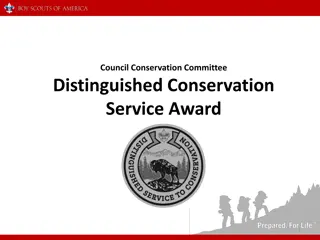Collaborative Vision and Action for Great Lakes Conservation
Empowering collaboration among various stakeholders to optimize Great Lakes and tributaries for aquatic species' population and genetic diversity, energy flow, and social objectives. The mission aims to establish connectivity targets and tools based on scientific evidence within the basin, while key actions include establishing shared habitat priorities, promoting best practices, and advancing research for informed decision-making.
Download Presentation

Please find below an Image/Link to download the presentation.
The content on the website is provided AS IS for your information and personal use only. It may not be sold, licensed, or shared on other websites without obtaining consent from the author. Download presentation by click this link. If you encounter any issues during the download, it is possible that the publisher has removed the file from their server.
E N D
Presentation Transcript
Collaborative Vision and Mission Collaborative Vision and Mission Vision: A connected Great Lakes and their tributaries optimized to: increase or maintain population levels and genetic diversity of desired aquatic species; to allow bi-direction movement of energy and nutrients by fish; prevent unacceptable population increases of detrimental species; and, meet economic and social objectives. Mission: To work collaboratively within a diverse set of governments, industries, non-governmental organizations, and the public to establish connectivity targets and decision support tools within the Great Lakes basin based on the best available science. (charter p. 2)
Collaborative Vision and Mission Collaborative Vision and Mission Vision: A connected Great Lakes and their tributaries optimized to: increase or maintain population levels and genetic diversity of desired aquatic species; to allow bi-direction movement of energy and nutrients by fish; prevent unacceptable population increases of detrimental species; and, meet economic and social objectives. Mission: To work collaboratively within a diverse set of governments, industries, non-governmental organizations, and the public to establish connectivity targets and identify and address limiting factors, within the Great Lakes basin based on the best available science. (charter p. 2-3)
Collaborative Key Actions Collaborative Key Actions Establish shared aquatic habitat priorities and connectivity targets Compile existing priorities/targets (Carter, Khoury and Walter) Support progress toward mutually agreed upon connectivity targets Compile existing funding sources and objectives (Carter, Khoury and Walter) Communication plan development (Collaborative with DJ Case & Associates) Promote the development and acceptance of best practices Communications plan development (Collaborative with DJ Case & Associates) Stimulate research and advance knowledge for improved connectivity decision making Compile existing connectivity research (Carter, Khoury and Walter) Fruit belt case study investigation (Burroughs, Khoury, Milt, Sheahan, Shook) (charter pp. 2-3)
Continued Priority Objective Development Continued Priority Objective Development Address a lack of standardized, publicly available inventory information Develop a mutually-agreed upon method for prioritizing species or watersheds Develop research priorities



























